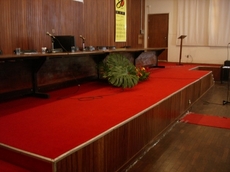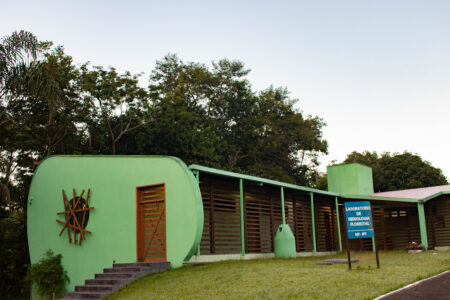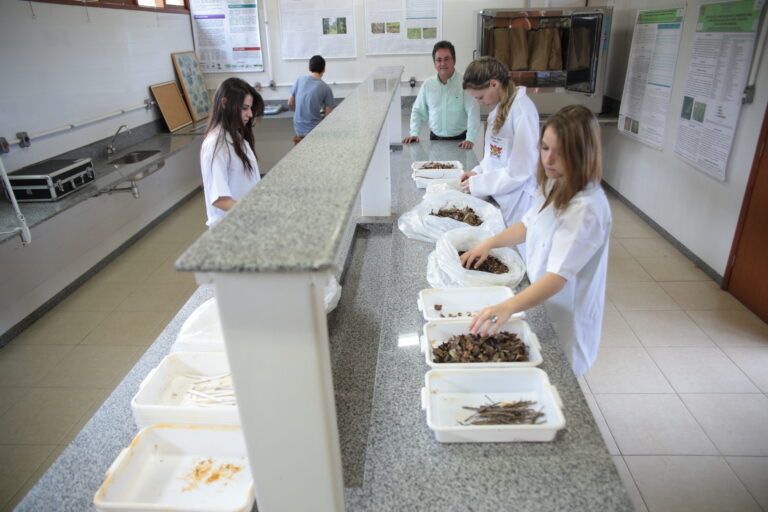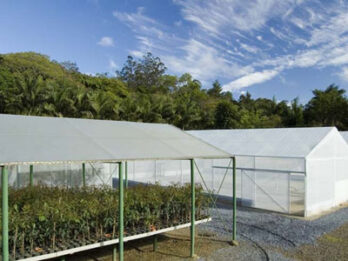Infrastructure
Main building
Located on Avenida PH Rolfs, no number, UFV University Campus, Viçosa – MG – Brazil, in the Reinaldo de Jesus Araújo building, is the main building of the Department of Forest engineering , where its main administrative activities are concentrated, some of its laboratories and also most of its classrooms.

The building has 3 floors, distributed as follows:
1st floor:
Forest Engineering Department Auditorium
Capacity: 300 seats
Stage dimensions: 3.27m high, 3.57m wide and 12.95m long
Audiovisual resources: 3 microphones on the table, 1 stand microphone, piano, 2 speakers and 1 projector (ceiling), internet point.
Infrastructure: air conditioning; upholstered chairs, blackout curtains, parquet flooring, with non-slip walkway.
- Geoprocessing Laboratories
- Currently, Geoprocessing has 3 rooms, all in the Forest engineering Department. In room 9 is the SIGMA laboratory – SOLUTIONS IN GEOGRAPHIC INTELLIGENCE FOR THE ENVIRONMENT, where classes and courses on Geographic Information Systems are taught. The laboratory has a large space, divided between classroom and research used to better serve undergraduate and graduate students. In room 4, remote sensing and GPS courses are taught, covering undergraduate and graduate courses. In room 3 there is a large collection of aerial photos obtained from metric and non-metric cameras, dating from the 1960s to the present day. With the help of stereoscopes, images are manipulated and used in retrospective studies, environmental impact and forest restoration.
- Computer lab
- Study room for Graduate students.
- DEF sector library.
- SIF – Forestry Research Society
- Our work with forestry companies and pulp and paper industries, wood panels and charcoal-fired steel mills over these 45 years is the result of professionalism, proactivity and integrity, seeking to innovate and promote sustainability in these companies.
- This public-private partnership provides resources for modernizing laboratories and hiring professionals qualified to conduct research coordinated by renowned professors in the forestry and environmental areas. All knowledge generated is made available to society in the form of publications, through Revista Árvore, Jornal SIF, newsletters and website.
- Created in 1974 by a partnership between the Federal University of Viçosa (UFV) and the main forestry companies in Brazil, SIF aims to support the development of research and professional qualifications based on scientific, economic and socio-environmental projects.
2nd floor:
- Jr. Forestry Company
- A non-profit Civil Association of Forestry Consulting, constituted and managed exclusively by undergraduate students of the Forest engineering course at the Federal University of Viçosa. Rooms 101, 116 and 117
- Forest Economics and Management Laboratories
- The Forest Economics and Management Laboratories, located in rooms 11, 111, 112 B and C and 118 of the Department of Forest engineering (DEF), at the Federal University of Viçosa, aim to support teaching, research and extension activities. They have a broad structure with computers, software and equipment for measuring and analyzing dendrometric variables, which are used in undergraduate and graduate classes and in the development of research and extension projects.
- Furthermore, the Laboratories serve as a support base for students (interns, scientific initiation and extension scholarship holders, master's and doctoral students) for their scientific technical improvement and also as support for developing work in partnerships with public and private institutions, in order to to promote improvements in the economic, measurement and forest management sectors.
- Classrooms
- The department has classrooms equipped with computers with internet access, projector (ceiling), air conditioning, equipment for video conferences and recordings, rooms 112 A, 110, 109, 108, 107, 106 B
- Forest Economics and Management Laboratories
- Study group rooms.
- Meeting room (106 A)
- Secretariats
- General Secretariat, Undergraduate Secretariat and Graduate Secretariat.
- Office of the Head of the Forest Engineering Department
3rd floor:
- Professors’ offices
- Revista Árvore (Journal)
Forest Seed Analysis Laboratory (LASF)
Forest Seed Analysis Laboratory (LASF)
LASF was created in 1967 with the hiring of Professor José Flávio Cândido, to the chair of Forest Seed Technology at DEF/UFV. In 1976, Professor Eduardo Euclydes de Lima e Borges was hired to work in the area of seed physiology. Today Prof. Eduardo is the coordinator of LASF. It has two employees for routine seed analysis, quality control of germplasm stock, research and assistance in practical classes. It also has a team of four field support employees for collecting and processing seeds. The flow of seeds for research and teaching is maintained by selected mother trees of native species.
LASF has 400 m² of internal area, divided between classrooms, laboratories and offices, being one of the best equipped forest seed study centers in Brazil, having, among others, liquid and gas chromatographs, spectrophotometers, ultra freezers, greenhouses BOD type, cold chamber, refrigerated centrifuges and freeze dryer. The activities developed by LASF involve the selection of parent trees, collection, processing and storage. Research is carried out involving the physiology and biochemistry of thermal and water stress during germination, with emphasis on reactive oxygen substances and the antioxidant system, the enzymatic system involved in metabolism during germination, and physiological changes during storage.
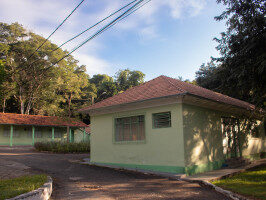
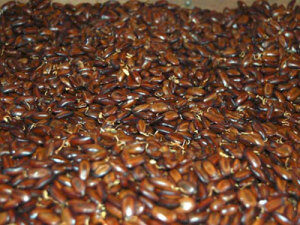
Pulp and Paper Laboratory (LCP)
Pulp and Paper Laboratory (LCP)
The Pulp and Paper Laboratory (LCP) is part of the Forest engineering Department of the Federal University of Viçosa (UFV). Opened on December 2, 1970, LCP has been dedicated to teaching, research and technical assistance in the area of pulp and paper. In 1998, LCP was recognized by the Ministry of Science and Technology as a Center of Excellence, receiving resources from the Support Program for Centers of Excellence – PRONEX.
Its professionals, through direct action or in collaboration with other local, state and national entities, work not only in teaching at undergraduate, graduate (lato-sensu, master's and doctorate specialization) and short-term courses, but also in research, technical-scientific advice and provision of services for national and international companies in the pulp and paper area.
In the teaching area, LCP offers undergraduate and graduate courses, having trained more than 60 master's and doctoral students over the last 35 years. Furthermore, it has trained more than 270 professionals in the lato-sensu program, training them in detailed technical-scientific knowledge to better operate the cellulose industry in a sustainable, environmentally compatible manner, with low production costs, competitive in the international market and with high quality of its products.
The LCP, through research, seeks to provide subsidies to national industries to solve their problems relating to raw materials, processes and environmental control. Through the provision of services, evaluating technological processes, raw materials, cellulose, paper and other materials, it generates information that assists the cellulose and paper industries and their suppliers in making technical decisions. Through consultancy and technical assistance, it operates both in conducting research programs and in resolving technical problems relating to companies in the sector.
The LCP has laboratory facilities that enable the main tests and analyzes of cellulose and paper to be carried out, as well as the laboratory-scale production of these products. The main objectives of the LCP are the training of professionals at master's and doctorate levels as well as carrying out basic and applied research necessary for the technological development of the national cellulose and paper industry.
LCP professionals have extensive experience in executing agreements with government entities and national and international private companies, remaining associated with other institutions to exchange technical information and carry out cooperative studies and research.

Nature Conservation Laboratory (LCN)
Nature Conservation Laboratory (LCN)
The Nature Conservation Laboratory (LCN) is part of the structure of the Department of Forest engineering , at the Federal University of Viçosa, aiming to integrate teaching, research and extension, related to environmental conservation. In the context of the Department of Forest engineering , the laboratory is linked to the Environment area and has, among its general objectives, the mission of developing research, studies and extension and environmental education activities on the Creation and Management of Protected Areas and Environmental Education and Interpretation .
The Nature Conservation Laboratory (LCN) was created through an agreement between UFV (Federal University of Viçosa), IEF (State Institute of Forests of Minas Gerais) and SIF (Society of Forestry Investigations) and opened in December 2006 , under the name of Forest Fires and Nature Conservation Laboratory (LIFCN). In 2012, the Laboratory managers, professors Guido Assunção Ribeiro and Gumercindo Souza Lima, decided to split the organic structure of LIFCN into two laboratories: Forest Fire Laboratory and Nature Conservation Laboratory, keeping part of the structure exclusive to each laboratory. and part of common use.
The LCN team is made up of professors, employees and students from the institution and works on developing research in Conservation Units and other protected areas, in addition to carrying out Environmental Education and Interpretation activities. Several interns make up the LCN team, distributed across the Research Group and GEIA (Environmental Education and Interpretation Group).
In addition to the physical structure of the LCN, located at Mata da Silvicultura, comprising the Research Office, Warehouse, counters, Toilets and classroom, there is also the structure located at the Mata do Paraíso Research, Training and Environmental Education Station, comprising the Entrance, Secretariat, Classroom, Storerooms, Kitchen, Restrooms, Environmental Education Center, Researcher's Office and three Environmental Interpretation Trails (Gameleira Trail, Caminho das Águas Trail and Giants Trail).
The LCN is also responsible for the National Symposium on Protected Areas (SNAP), started in 2008. SNAP – National Symposium on Protected Areas is an event promoted every two years by the UFV Nature Conservation Laboratory in partnership with public bodies and companies of the environmental sector and aims to exchange experiences and information between researchers, professionals and managers of protected areas, contributing to the strengthening of these throughout the national territory.
Forest Ecology and Physiology Laboratory (LEF)
Forest Ecology and Physiology Laboratory (LEF)
O Laboratório de Ecologia e Fisiologia Florestal (LEF) tem como finalidade dar suporte às atividades de ensino, pesquisa e extensão em área que envolve o conhecimento da dinâmica de crescimento das plantas em habitats naturais e artificiais. Procura-se, nas pesquisas, o entendimento das condições ambientais e suas relações com as plantas, o que favorece a escolha de métodos de manejo dos ecossistemas florestais naturais e artificiais, visando aumento da sua produtividade de forma sustentável.
Recentemente, tem sido dada ênfase ao uso múltiplo das florestas plantadas, especialmente para serraria e fabricação de móveis, em substituição a espécies florestais nativas. Para subsidiar a tomada de decisões sobre a forma de aplicar a desrama artificial, estão sendo desenvolvidos estudos de avaliação do crescimento das árvores e da qualidade da madeira em povoamentos de eucalipto submetidos a desrama artificial, o que tem possibilitado a orientação da aplicação comercial desta técnica.
Os estudos de florestas nativas relativos a mapeamento e descrição dos fragmentos florestais e, dinâmica da regeneração natural de florestas nativas secundárias, permite a orientação de seu manejo adequado visando a sua sustentabilidade. Como resultado desses estudos, é possível a obtenção de florestas de produtivas, envolvendo a obtenção de produtos de melhor qualidade nas florestas implantadas, e, maior biodiversidade nas florestas nativas.
Forest Economics and Management Laboratories
Forest Economics and Management Laboratories
The Forest Economics and Management Laboratories, located in rooms 11, 111, 112 B and C and 118 of the Department of Forest engineering (DEF), at the Federal University of Viçosa, aim to support teaching, research and extension activities. They have a broad structure with computers, software and equipment for measuring and analyzing dendrometric variables, which are used in undergraduate and graduate classes and in the development of research and extension projects.
Furthermore, the Laboratories serve as a support base for students (interns, scientific initiation and extension scholarship holders, master's and doctoral students) for their scientific technical improvement and also as support for developing work in partnerships with public and private institutions, in order to to promote improvements in the economic, measurement and forest management sectors.
Ergonomics and Forest Harvesting Laboratory (LABERGO)
Ergonomics and Forest Harvesting Laboratory (LABERGO)
The Laboratory of Ergonomics and Forest Harvesting – LABERGO (DEF-UFV), created in 1984, aims to provide means to carry out teaching, research, extension, innovation, studies and consultancy in the forestry, agricultural and production engineering areas and serve as support to undergraduate and graduate work on courses and programs related to the Department of Forest engineering and the Department of Production and Mechanical Engineering (DEP).
The Laboratory building has:
1. Eight rooms for equipment, classes and support, totaling approximately 500 m².
2. Modern instruments for measuring energy expenditure, aerobic capacity, anthropometry, audiometry, thermal environment, air speed, air humidity, vibration, noise, heart rate, lighting, biomechanics (strength, posture), body mass index, among others .
3. Methodologies and software for ergonomic assessment and forest harvesting operations.
4. Manual tools, chainsaws and other equipment for use in research, teaching and extension in the Forest Harvest area.
5. Collection of books and journals for use in the areas of Ergonomics and Forest Harvesting.
6. Computers, laptops and supporting furniture.
The Laboratory's materials and methods are used in research carried out at undergraduate (Scientific Initiation, Monographs and Internships) and graduate (master's and doctorate) levels in linked departments that have research partnerships and student supervision.
Since 2000, LABERGO has organized the event called the Brazilian Symposium on Ergonomics and Safety in Forestry and Agricultural Work – ERGOFLOR.
The laboratory serves the teaching of the Forest engineering and Production and Mechanical Engineering courses in partnership with Professor Luciano José Minette.
Geoprocessing Laboratory
Geoprocessing Laboratory
In the context of the Department of Forest engineering , Geoprocessing is linked to the management area and aims to support teaching, research and extension activities. Based on the Geographic Information System and Remote Sensing, the geoprocessing team at the Department of Forest engineering has been developing research in different areas of knowledge and with relevant and innovative applications in our society.
Currently, Geoprocessing has 3 rooms, all in the Forest engineering Department. In room 9 is the SIGMA laboratory – SOLUTIONS IN GEOGRAPHIC INTELLIGENCE FOR THE ENVIRONMENT, where classes and courses on Geographic Information Systems are taught. The laboratory has a large space, divided between classroom and research used to better serve undergraduate and graduate students. In room 4, remote sensing and GPS courses are taught, covering undergraduate and graduate courses. In room 3 there is a large collection of aerial photos obtained from metric and non-metric cameras, dating from the 1960s to the present day. With the help of stereoscopes, images are manipulated and used in retrospective studies, environmental impact and forest restoration.
Geoprocessing has a team of Professors and undergraduate, master's and doctoral students. It is currently coordinated by professors José Marinaldo Gleriani, Cibele Hummel do Amaral and Alexandre Simões Lorenzon.
SIGMA is also responsible for the Geographic Information System Day (GISday UFV), started in 2013, and the Software Applied to Agricultural Sciences Week (SSACA), started in 2017. These events have as their main objective the creation of a space for updating and exchanging experience between students, professors, researchers and professionals in the field of geotechnology.
Forest Hydrology Laboratory (LHF)
Forest Hydrology Laboratory (LHF)
The Forest Hydrology Laboratory (LHF) was opened on December 7, 2009 and is linked to the Department of Forest engineering . Located at the Silviculture Sector (Mata da Silvicultura), LHF houses several Forest Hydrology and Watershed Management projects, which seek to study and understand water in different ecosystems. Its strong focus is the recovery, preservation and conservation of springs. It has been a great option for an internship and a strong collaboration in the graduate course of the Graduate Program in Forest Sciences. With the water deficit that our region, as well as others in the country, has experienced, the LHF has been sought out for various demands, including consultation on the occurrence of rain and the volume of precipitation.
Forest Fire Laboratory
Forest Fire Laboratory
The Forest Fire Laboratory makes up the infrastructure of the Department of Forest Engineering at the Federal University of Viçosa to support teaching, research and extension. Within the Department of Forest engineering , the laboratory is linked to the Environment area and has, among its general objectives, the mission of promoting the development and integration of all the department's environmental sub-areas.
Protection against forest fires has its history linked to the motivation for creating the Forest engineering course in Brazil and since its inception the subject has been regularly treated as a course. The increase in the area of planted forests in Brazil and the growing concern with the conservation of natural resources, especially conservation units, require every day the improvement of equipment, products, prevention and combat techniques, and the training of brigades of fires, the implementation of preventive silvicultural methods and the use of new technologies for monitoring and detecting forest fires. More recently, the negative pressure that forest fires have exerted on various business activities and the negative effects they produce on obtaining forest certification, with the emission of gases and other effects on the environment, motivated the formation of partnerships between the Federal University of Viçosa, through the Department of Forest engineering and the Society of Forestry Research with the Companhia Energética de Minas Gerais and the State Forestry Institute. These facts resulted in the acquisition of various equipment and culminated in the construction of the laboratory comprising a researcher's office, warehouse, service area, a large environment consisting of counters for storing equipment, a combustion table, greenhouses, scales and work tables and a for storing field material.
The laboratory's mission is to develop studies, research and projects that contribute to environmental protection in Brazil. The laboratory's main objectives are to: develop studies on fire behavior and the occurrence of forest fires in Brazil; undertake studies on fire ecology and the effects of fire on the environment; carry out training and capacity building in forest fire control; develop educational activities aimed at conserving and protecting natural resources; develop graduate thesis, scientific initiation projects and monographs, aiming at technical-scientific development and improvement; carry out environmental examinations and reports; develop, test and improve techniques, products and equipment to prevent and combat forest fires.
Wood Panels and Energy Laboratory (LAPEM)
Wood Panels and Energy Laboratory (LAPEM)
LAPEM was inaugurated in August 1988, with the aim of supporting the Department of Forest engineering of the Federal University of Viçosa (DEF/UFV) in teaching, research and extension activities, in the areas of Adhesives and Panels, Bioenergy and Wood Quality .
The laboratory activities are coordinated by professors Benedito Rocha Vital and Angélica de Cássia Oliveira Carneiro.
LAPEM professionals and students work in teaching, research and extension activities, including technical-scientific advice, provision of services to society, in addition to working directly in research and development projects. In teaching, several undergraduate and graduate courses are offered on LAPEM's premises, in addition to training and internship opportunities for countless students from other courses and institutions, promoting their technical-scientific qualifications. Through research activities, subsidies are provided to national industries and society as a whole, to solve problems relating to raw materials and processes in different areas of activity.
LAPEM has various equipment that allows advanced research, contributing to science and also to undergraduate and graduate education. Therefore, LAPEM is responsible for carrying out R&DI in the area of bioenergy for the use of renewable sources of biomass, mainly wood from planted forests for the production of biofuels and biomaterials. Also carry out research in the area of wood panels and agricultural/industrial waste, and development of adhesives based on lignin, tannins and castor beans, in addition to studying synthetic resins.
LAPEM professionals work directly to promote innovation and the development of good socioeconomic and environmental practices, promoting the development of the wood technology sector.
Wood Properties Laboratory (LPM)
Wood Properties Laboratory (LPM)
The Laboratory of Physical and Mechanical Properties of Wood (LPM) is aligned with the most modern equipment and technologies in Brazil linked to the study of characterization of wood and its derivatives, remaining in tune with the new world order, which foresees the rational and sustainable use of wood, as an important raw material. With 1,802 m2 of built area and the most modern equipment, the laboratory is capable of carrying out the vast majority of physical-chemical-anatomical-mechanical tests on wood, machining, drying and preservation of wood, under the responsibility of highly qualified professors and technicians. Furniture and civil construction sector. Linked to the Department of Forest engineering at UFV, the laboratory meets the various demands of teaching, research and extension, as well as serving companies and institutions, mainly linked to the furniture and civil construction activities.
Due to all these advances, the Wood Properties Laboratory is available to the community to carry out tests, courses and lectures within the topics within its competence.
Forest Industry Waste Laboratory
Forest Industry Waste Laboratory
The Forest Industry Waste Laboratory aims to provide means to carry out research and studies on the management of solid waste from the forest-based industry, serving as support for undergraduate and graduate teaching of courses and programs related to the Departments of Forest engineering and of Environmental Engineering.
Forest Restoration Laboratory (LARF)
Forest Restoration Laboratory (LARF)
The LARF – Forest Restoration Laboratory , linked to the Department of Forest Engineering at the Federal University of Viçosa, is located on the UFV campus in Viçosa, MG, at the Silviculture Sector (Mata da Silvicultura).
LARF was created with the aim of enabling, through agreements with private companies in the mining, forestry (cellulose and paper, charcoal) and energy generation sectors, consultancy and research on ecological restoration of Permanent Preservation Areas and Legal Reserves, mined areas and environmental compensation. . Through these partnerships, it has also been possible to develop master's dissertations and doctoral theses, generating new low-cost forest restoration methodologies and training new professionals for the job market in the environmental sector.
The ecological restoration projects developed by LARF focus on the development and/or adaptation of nucleation techniques such as top soil and litter, perches, branchery, seedling nuclei, seed rain, as well as techniques for controlling invasive species, fertilization, arrangements and spacing of reforestation with native species, enrichment, among others.
Research and consultancy in ecology and forest restoration have been carried out by LARF in the states of Minas Gerais, Rio Grande do Sul, Rio de Janeiro, Espírito Santo, São Paulo, Santa Catarina, Mato Grosso, Amazonas and Tocantins. Contacts and information about LARF projects, publications and events can be accessed at the link below.
Sectors
Sectors
Dendrologia
O laboratório de Dendrologia foi criado em 1965 com o objetivo de estudar espécies vegetais arbóreas, nativas e exóticas, especialmente as que ocorrem na região de Viçosa. O setor também dá suporte ao ensino, pesquisa e à extensão do DEF, fornecendo subsídios para o melhor reconhecimento das espécies arbóreas, principalmente aquelas de florestas tropicais.
Mata do Paraíso
Estação de Pesquisas, Treinamento e Educação Ambiental (EPTEA) Mata do Paraíso
A Mata do Paraíso é uma reserva de Mata Atlântica, com fragmento de cerca de 400ha, sendo que a Estação abrange 200ha desse fragmento, em excelente estado de conservação. A área abriga diversas espécies da fauna e flora ameaçadas de extinção e protege ainda as nascentes do Córrego Santa Catarina, importante afluente do Ribeirão São Bartolomeu. A área dispõe, ainda, de trilhas e um Centro de Educação Ambiental. O espaço recebe cerca de 3.000 visitantes por ano, entre pesquisadores, estudantes da educação infantil, ensinos fundamental, médio e superior além de famílias de Viçosa e cidades da região.
Até 1966, a Mata do Paraíso p ertencia a Prefeitura Municipal de Viçosa. Sendo até a época utilizada como reservatório e fonte de água para o abastecimento do município, e como fonte de madeira. Desde então a área pertence a Universidade Federal de Viçosa, sendo administrada pelo Departamento de Engenharia Florestal.
A Universidade Federal de Viçosa, através de seus Departamentos, utiliza a Mata do Paraíso para a realização de aulas práticas e pesquisas científicas, tendo a Mata como um laboratório natural de grande valia para desenvolvimento do aprendizado in situ, bem como fonte de dados concretos das relações e inter-relações de um ecossistema.
A Mata do Paraíso localiza-se no município de Viçosa que está localizado ao norte da Zona da Mata de Minas Gerais, a 229 Km da capital Belo Horizonte. Situado entre as latitudes de 20º41’20’’S a 20º49’35’’S e, entre as longitudes de 42º49’36’’ W a 42º54’27’’W, a uma altitude média de 650 metros, o município abrange uma área de 300,15 km2 (IBGE, 1996). A Mata do Paraíso situa-se a aproximadamente 6 Km da Universidade Federal de Viçosa e possui uma área de 194 hectares.
Silvicultura
O Setor de Silvicultura do Departamento de Engenharia Florestal da UFV possui enfoque na cultura de espécies florestais exóticas e nativas, dendrologia, ecologia florestal, tecnologia e produção de sementes florestais, propagação de espécies florestais, práticas silviculturais, genética e melhoramento florestal, sistemas agroflorestais, silvicultura clonal, solos e fertilização florestal e biotecnologia florestal. Possui laboratórios como os de Análise de Sementes Florestais (LASF), de Ecofisiologia Florestal (LEF), Viveiro Florestal, Dendrologia e áreas de campo constituídas por florestas naturais e implantadas.
Viveiro Florestal
Missão :
Atender as atividades de Ensino, Pesquisa e Extensão, em especial do Departamento de Engenharia Florestal e do Programa de Pós-Graduação, em nivel de mestrado e doutorado, em Ciências Florestais, da Universidade Federal de Viçosa.
Promover o desenvolvimento técnico-científico, com alto padrão de qualidade, da área de propagação de espécies florestais nativas e exóticas.
Objetivo:
Produzir mudas de espécies florestais nativas e exóticas de grupos ecológicos distintos, pelos métodos sexuados e assexuados.
Servir de laboratório para pesquisa e experimentação sobre propagação, exigências nutricionais e manejo de viveiro de espécies florestais.
Possibilitar treinamento de estudantes de ensino médio e superior, matriculados em cursos afins à Ciência Florestal, na forma de estágio voluntário ou curricular.
Estrutura:
O viveiro florestal ocupa área de 22.000 m2, onde são conduzidas as atividades de ensino, pesquisa e extensão, pertinentes à área de propagação de espécies arbóreas, sendo dividido em viveiro de pesquisa.
O viveiro de pesquisa possui casa de vegetação climatizada, com controle de temperatura e umidade relativa do ar, com capacidade para 48.000 mudas; casa de sombra com igual área; casas de vegetação, sendo a primeira para o desenvolvimento de pesquisas em vasos, com espaço para abrigar 1.000 vasos de 2,5 dm3 de capacidade e a segunda com área de 280 m2 para o desenvolvimento de pesquisas em geral; área protegida com 340 m2; pátio para crescimento e rustificação de mudas, com canteiros suspensos, para pesquisas relacionadas com a produção de mudas em tubetes; pátio com canteiros a pleno solo, para pesquisas relacionadas com a produção de mudas em sacolas plásticas; sala de aula, com capacidade para 30 lugares, onde são ministradas partes de aulas práticas. Possui, também, um jardim clonal, com irrigação por gotejamento, e um minijardim clonal em canaletão, com sistema de fertirrigação por gotejamento, para estudos de propagação vegetativa por estaquia e miniestaquia, respectivamente.
Ainda nas dependências do viveiro florestal, em parceria com o Instituto Estadual de Florestas, do Estado de Minas Gerais, existe área para a produção de mudas destinadas ao fomento florestal, com capacidade para produção de 3.000.000 mudas por ano.



